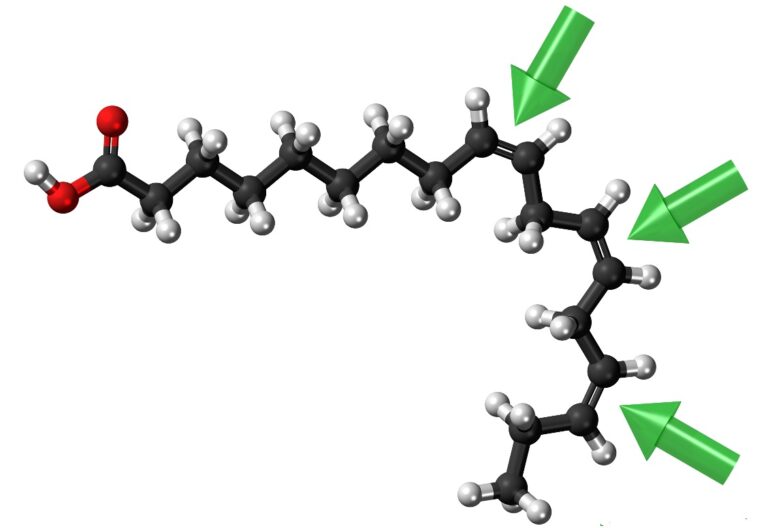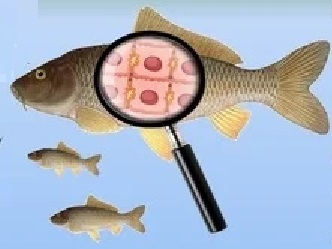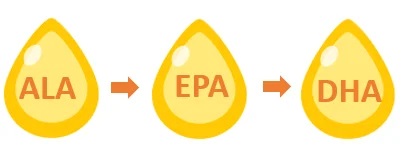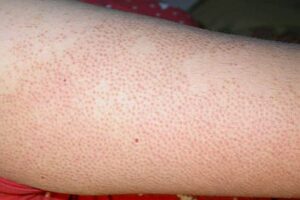
Inhibitors / Enhancers of Omega-3 ALA and Omega-6 LA conversions to EPA / DHA and GLA
Diet, age, health, genes, other conditions affect conversion

Abbreviations: PUFAs (Polyunsaturated Fatty Acids), incl. the EFAs (Essential Fatty Acids):
Omega 6 (O6)
- LA (linolenic acid)
- GLA (gamma-linolenic acid)
- DGLA (Dihomo-gamma-linolenic)
- AA (Arachidonic acid)
Omega-3 (O3):
- ALA (alpha linolenic acid)
- SDA (stearidonic acid)
- EPA (Eicosapentaenoic acid)
- DHA (Docosahexenoic Acid)

Enhancers to O3 ALA to EPA/DHA conversion
Diet more important than genetics
Dr. Udo Erasmus (World-renowned expert on fats / Author of “Fats that Heal, Fats that Kill”) considers that the ability to convert ALA to DHA is influenced to a greater degree by diet than by genetics
Diet
Specific minerals and vitamins are required by the conversion enzymes. Vitamins B3, B6 and C, Magnesium and Zinc.
Omega-6 GLA presence. Found in such as borage, blackcurrant and evening primrose oils.
High ratio Protein: Carbohydrate intake
Phytoestrogens. ALA conversion in women is higher than in men, and one conversion study showed that women on birth-control pills (containing estrogen) had better conversion rates, suggesting that estrogen is a contributing factor. Pregnant or breast-feeding women need to produce enough DHA to supply not only their brain, but also the brain of a developing fetus or breast-feeding child (Men have only their brain to feed 😉). Estrogen levels are higher during the child-bearing years.
It is interesting that flax seed (not oil) contains lignans, which when taken in amounts over a certain threshold, increase estrogen levels. Amounts under this threshold (E.g. 2-3 Tbsp. ground flax/day) have the opposite effect and actually reduce estrogen activity as the phytoestrogenic lignans compete for estrogen receptors but have a weaker effect than estrogen.
Phytosterols. Plant-derived compounds similar in structure/function to cholesterol, inhibit intestinal absorption of cholesterol. (Minimum 0.8g of plant sterols lowers serum cholesterol). Foods rich in phytosterols include unrefined vegetable oils, whole grains, nuts, and legumes.

Inhibitors to O3 ALA to EPA/DHA conversion
Inhibitors to O3 ALA to EPA/DHA conversion ENZYMES
Altered Fats. Such as found in margarine, shortening and other processed or heated oils.
Lack of Certain Vitamins and Minerals needed for conversion enzymes (specifically vitamins B3, B6 and C, Magnesium and Zinc)
Cholesterol and Long-Chain Saturated Fat (from meat and dairy) compete for conversion enzymes).
LA to ALA Imbalance (LA and ALA compete for enzymes).
Sugar, Chemicals, Caffeine
Excessive PALMITOLEIC fatty acids. A MUFA significantly found in milk and tropical oils.
AGE (over 30) – enzyme production diminishes with age; Health problems (E.g. Diabetes).
ALCOHOL, DRUGS, STRESS, HIGH INSULIN, ENVIRONMENTAL CHEMICALS.
ANCESTRY ACCUSTOMED TO A HIGH FISH DIET (E.g. Inuit, Oriental, West Coast N. American native, Norwegian).





















